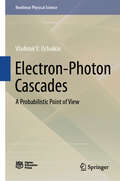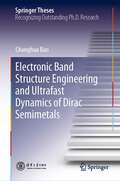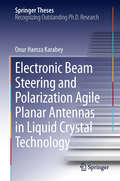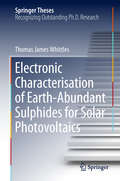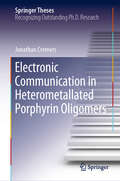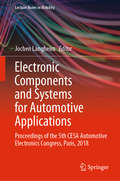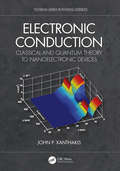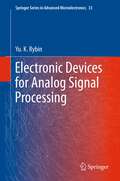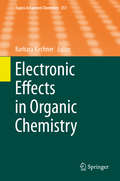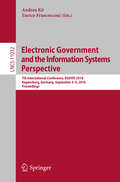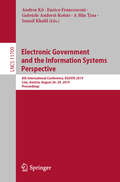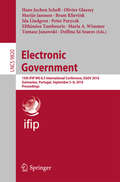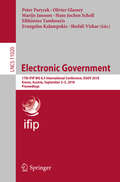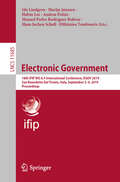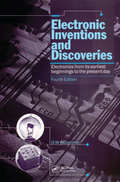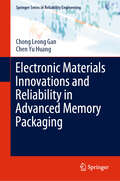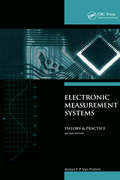- Table View
- List View
Electron-Photon Cascades: A Probabilistic Point of View (Nonlinear Physical Science)
by Vladimir V. UchaikinThis book demonstrates the practical application of an alternative approach to current problems in high-energy astrophysics. In high-energy astrophysical processes, single collisions are accompanied by the appearance of many secondary particles with different properties. To describe the infinitesimal evolution of such a system at a measurement instant, as is commonly done when deriving the kinetic equation for the system with conserved number of particles, one must know either its prehistory or the infinite family of many-particle distributions. An alternative to this approach is to use an adjoint (in the sense of Lagrange) mathematical formalism, where the independent active variable is the phase position of a primary particle generating the cascade, and the dependent variable has the form of a functional of the cascade as a whole, interpreted as the reading of some not necessarily linear (additive) detector. This approach is characterized by mathematical efficiency: no matter how many particles are formed in a cascade, the active argument of the desired functional always remains one particle. The second advantage is its generality: the formalization of the readings of the detector, which performs real measurements through the functionality of a random implementation of the cascade, allows it to be applied to a wide range of actually used devices and installations.Readers will be able to master the fundamentals of particle astrophysics in the context of the latest developments in the field. It will benefit graduate students and established researchers alike, equipping them with the knowledge and tools necessary to design and interpret their own experiments and, ultimately, to address a number of questions about the nature and origin of cosmic particles that have arisen in recent research.
Electronic Band Structure Engineering and Ultrafast Dynamics of Dirac Semimetals (Springer Theses)
by Changhua BaoThis book highlights the doctoral research of the author on electronic band structure engineering and ultrafast dynamics of Dirac semimetals. Dirac semimetals exhibit unique electronic band structure and novel physical properties with rich light-matter interaction, which inspires a wide range of potential applications. Enabling band engineering and revealing ultrafast dynamics of Dirac semimetals is therefore important. In the research work covered by the book, the first ultrafast time- and angle-resolved photoemission spectroscopy with tunable probe photon energy is developed, providing new opportunities for exploring ultrafast dynamics in 3D quantum materials. Using the spectroscopy, the author investigates the band structure engineering and ultrafast dynamics of Dirac semimetals, realizing the long-sought-after chiral symmetry breaking in a Kekulé-ordered graphene with flat band and revealing the ultrafast dynamics of Dirac fermions in 3D Dirac semimetal for the first time. The work advances the research of the electronic structure of Dirac semimetals in two aspects. Firstly, it identifies the Kekulé-ordered graphene as a new system for exploring chiral symmetry breaking- related physics and flat band- induced instability, providing a very rare system to investigate their interplay. Secondly, it solves the long-standing challenge of directly visualizing the non-equilibrium electronic structure of 3D Dirac semimetal and opens up new opportunities for exploring the light-matter interaction in 3D quantum materials, especially the light-induced topological phase transitions in 3D topological materials.
Electronic Beam Steering and Polarization Agile Planar Antennas in Liquid Crystal Technology
by Onur Hamza KarabeyThis book describes the characterization of liquid crystal materials at microwave frequencies and the usage of these materials in reconfigurable planar antennas and in their electrical tunable components. It reports for the first time the realization of a two-dimensional electronic beam steering antenna and polarization agile planar antennas with liquid crystal display technology. It gives a detailed description of all the theoretical analyses, modeling and design methods that were involved in the realization of these devices as well as their validation using measurement of demonstrative prototypes. This book also shows that low profile, low cost, high gain, electronic beam steering and polarization agile antennas can be fabricated in larger sizes by using existing automated liquid crystal display manufacturing techniques. The innovative ideas and method described in this work represent a considerable advancement in the field of electronically reconfigurable antennas based on liquid crystal technology and are expected to draw significant interest in the future. Such antennas may become important, for example, in mobile terminals integrated into the body of laptops (in the cover) or of automobiles (in the rooftop), ships or boats, for which flat, low-profile and low-cost antennas are required.
Electronic Characterisation of Earth‐Abundant Sulphides for Solar Photovoltaics (Springer Theses)
by Thomas James WhittlesThis book examines the electronic structure of earth-abundant and environmentally friendly materials for use as absorber layers within photovoltaic cells. The corroboration between high-quality photoemission measurements and density of states calculations yields valuable insights into why these materials have demonstrated poor device efficiencies in the vast literature cited. The book shows how the materials’ underlying electronic structures affect their properties, and how the band positions make them unsuitable for use with established solar cell technologies. After explaining these poor efficiencies, the book offers alternative window layer materials to improve the use of these absorbers. The power of photoemission and interpretation of the data in terms of factors generally overlooked in the literature, such as the materials’ oxidation and phase impurity, is demonstrated. Representing a unique reference guide, the book will be of considerable interest and value to members of the photoemission community engaged in solar cell research, and to a wider materials science audience as well.
Electronic Collaboration in Science (Progress in Neuroinformatics Research Series)
by Michael F. Huerta Stephen H. KoslowThe increasingly sophisticated and powerful information technology we are creating plays an ever more prominent role in facilitating interaction and cooperation in everyday life. The time has come to harness it in the service of scientific research. This pathbreaking book describes the technical and social challenges and opportunities of electronic collaboration and offers specific examples of the ways in which it has not only facilitated but in some cases enabled work by scientists. Key players all, the chapter authors illuminate the general issues with their first-hand accounts. Very few researchers today can work in isolation. Electronic Collaboration in Science provides the first clear road map for all whose investigations are leading them into this fascinating new multidisciplinary domain.
Electronic Communication in Heterometallated Porphyrin Oligomers (Springer Theses)
by Jonathan CremersThis book cuts across the divisions of organic, inorganic, and physical chemistry. It describes new methods for creating π-conjugated porphyrin oligomers with precisely defined sequences of zinc and copper metal cations, and how EPR spectroscopy was used to investigate the dipolar and exchange coupling between the paramagnetic copper(II) centres.Porphyrins are a group of heterocyclic macrocycle organic compounds that play an important role in our everyday life and can for example be found in blood where they form a red complex with iron (haem). Various metallic elements can be inserted into a porphyrin and changing the coordinated metal is an excellent way to influence the chemical and physical properties of these molecules. Focusing on 3 metals - zinc, magnesium and copper - the author established new methods for creating π-conjugated porphyrin oligomers and lastly presents the synthesis and investigation of two novel porphyrin nanoballs. Giving the template-directed strategy the author developed for constructing these molecules, this work could provide access to other related nano-cages.
Electronic Components and Systems for Automotive Applications: Proceedings of the 5th CESA Automotive Electronics Congress, Paris, 2018 (Lecture Notes in Mobility)
by Jochen LangheimThis volume collects selected papers of the 5th CESA Automotive Electronics Congress, Paris, 2018. CESA is the most important automotive electronics conference in France. The topical focus lies on state-of-the-art automotive electronics with respect to energy consumption and autonomous driving. The target audience primarily comprises industry leaders and research experts in the automotive industry.
Electronic Conduction: Classical and Quantum Theory to Nanoelectronic Devices (Textbook Series in Physical Sciences)
by John P. XanthakisElectronic Conduction: Classical and Quantum Theory to Nanoelectronic Devices provides a concise, complete introduction to the fundamental principles of electronic conduction in microelectronic and nanoelectronic devices, with an emphasis on integrating the quantum aspects of conduction. The chapter coverage begins by presenting the classical theory of conduction, including introductory chapters on quantum mechanics and the solid state, then moving to a complete presentation of essential theory for understanding modern electronic devices. The author’s unique approach is applicable to microscale and nanoscale device simulation, which is particularly timely given the explosion in the nanoelectronics field. Features Self-contained Gives a complete account of classical and quantum aspects of conduction in nanometer scale devices Emphasises core principles, the book can be useful to electrical engineers and material scientists, and no prior course in semiconductors is necessary Highlights the bridge to modern electronics, first presenting the physics, and then the engineering complications related to quantum behaviour Includes many clear, illustrative diagrams and chapter problem sets Gives an account of post-Silicon devices such as the GaAs MOSFET, the CNT-FET and the vacuum transistor Showcases why quantum mechanics is necessary with modern devices due to their size and corresponding electron transport properties Discusses all the issues that will enable readers to conduct their own research
Electronic Devices for Analog Signal Processing
by Yu. K. RybinElectronic Devices for Analog Signal Processing is intended for engineers and post graduates and considers electronic devices applied to process analog signals in instrument making, automation, measurements, and other branches of technology. They perform various transformations of electrical signals: scaling, integration, logarithming, etc. The need in their deeper study is caused, on the one hand, by the extension of the forms of the input signal and increasing accuracy and performance of such devices, and on the other hand, new devices constantly emerge and are already widely used in practice, but no information about them are written in books on electronics. The basic approach of presenting the material in Electronic Devices for Analog Signal Processing can be formulated as follows: the study with help from self-education. While divided into seven chapters, each chapter contains theoretical material, examples of practical problems, questions and tests. The most difficult questions are marked by a diamond and can be given to advanced readers. Paragraphs marked by /// are very important for the understanding of the studied material and together they can serve a brief summary of a section. The text marked by italic indicates new or non-traditional concepts. Calculated examples are indicated by >. The main goal of Electronic Devices for Analog Signal Processing is not only to give some knowledge on modern electronic devices, but also to inspire readers on the more detailed study of these devices, understanding of their operation, ability to analyze circuits, synthesize new devices, and assess the possibilities of their application for solution of particular practical problems.
Electronic Effects in Organic Chemistry
by Barbara KirchnerThe series Topics in Current Chemistry presents critical reviews of the present and future trends in modern chemical research. The scope of coverage is all areas of chemical science including the interfaces with related disciplines such as biology, medicine and materials science. The goal of each thematic volume is to give the non-specialist reader, whether in academia or industry, a comprehensive insight into an area where new research is emerging which is of interest to a larger scientific audience. Each review within the volume critically surveys one aspect of that topic and places it within the context of the volume as a whole. The most significant developments of the last 5 to 10 years are presented using selected examples to illustrate the principles discussed. The coverage is not intended to be an exhaustive summary of the field or include large quantities of data, but should rather be conceptual, concentrating on the methodological thinking that will allow the non-specialist reader to understand the information presented. Contributions also offer an outlook on potential future developments in the field. Review articles for the individual volumes are invited by the volume editors. Readership: research chemists at universities or in industry, graduate students
Electronic Government and the Information Systems Perspective: 6th International Conference, EGOVIS 2017, Lyon, France, August 28-31, 2017, Proceedings (Lecture Notes in Computer Science #10441)
by Enrico Francesconi Andrea KőThis book constitutes the refereed proceedings of the 6th International Conference on Electronic Government and the Information Systems Perspective, EGOVIS 2017, held in Lyon, France, in August 2017. The 20 revised full papers presented were carefully reviewed and selected from 24 submissions. The papers areorganized in the following topical sections: digitalization and transparency; open data ecosystems; intelligent systems in e-government; e-government research and intelligent systems; m-government and inclusion; e-government cases - data knowledge management; and knowledge management in the context of e-government.
Electronic Government and the Information Systems Perspective: 7th International Conference, EGOVIS 2018, Regensburg, Germany, September 3–5, 2018, Proceedings (Lecture Notes in Computer Science #11032)
by Enrico Francesconi Andrea KőThis book constitutes the refereed proceedings of the 7th International Conference on Electronic Government and the Information Systems Perspective, EGOVIS 2018, held in Regensburg, Germany, in September 2018. The 19 revised full papers presented were carefully reviewed and selected from 22 submissions. The papers are organized in the following topical sections: digitalization and transparency; challenges in e-government technology and e-voting; knowledge management in the context of e-government; semantic technologies and the legal aspects; open data and open innovation; and e-government cases - data and knowledge management.
Electronic Government and the Information Systems Perspective: 8th International Conference, EGOVIS 2019, Linz, Austria, August 26–29, 2019, Proceedings (Lecture Notes in Computer Science #11709)
by Enrico Francesconi Andrea Kő Ismail Khalil A Min Tjoa Gabriele Anderst-KotsisThis book constitutes the refereed proceedings of the 8th International Conference on Electronic Government and the Information Systems Perspective, EGOVIS 2019, held in Linz, Austria, in August 2019. The 17 full papers presented were carefully reviewed and selected from 25 submissions. The papers are organized in the following topical sections: open data and open innovation; data-driven approaches in e-government; e-government cases – data and knowledge management; e-government theoretical background; and digitalization and transparency.
Electronic Government: 15th IFIP WG 8.5 International Conference, EGOV 2016, Guimarães, Portugal, September 5-8, 2016, Proceedings (Lecture Notes in Computer Science #9820)
by Efthimios Tambouris Maria A. Wimmer Delfina Sá Soares Tomasz Janowski Hans Jochen Scholl Marijn Janssen Bram Klievink Ida Lindgren Peter Parycek Olivier GlasseyThis book constitutes the refereed proceedings of the 15th IFIP WG 8.5 International Conference on Electronic Government, EGOV 2016, held in Guimaraes, Portugal, in September 2016, in conjunction with the 8th International Conference on eParticipation, ePart 2016. The 24 revised full papers presented were carefully reviewed and selected from 87 submissions. The papers are clustered under the following topical sections: foundations; benchmarking and evaluation; information integration and governance; services; evaluation and public values; EGOV success and failure; governance; social media; engagement; processes; policy-making; trust, transparency and accountability; open government and big/open data; smart government/governance/cities.
Electronic Government: 17th IFIP WG 8.5 International Conference, EGOV 2018, Krems, Austria, September 3-5, 2018, Proceedings (Lecture Notes in Computer Science #11020)
by Efthimios Tambouris Hans Jochen Scholl Marijn Janssen Peter Parycek Olivier Glassey Evangelos Kalampokis Shefali VirkarThis book constitutes the proceedings of the 17th IFIP WG 8.5 International Conference on Electronic Government, EGOV 2018, held in Krems, Austria, in September 2018, in conjunction with the 10th International Conference on eParticipation, ePart 2018.The 22 revised full papers presented were carefully reviewed and selected from 48 submissions. The papers are clustered under the following topical sections: General E-Government and Open Government; Open Data, Linked Data, and Semantic Web; Smart Governance (Government, Cities and Regions); and Artificial Intelligence, Data Analytics and Automated Decision-Making.
Electronic Government: 18th IFIP WG 8.5 International Conference, EGOV 2019, San Benedetto Del Tronto, Italy, September 2–4, 2019, Proceedings (Lecture Notes in Computer Science #11685)
by Efthimios Tambouris Hans Jochen Scholl Marijn Janssen Ida Lindgren Manuel Pedro Rodríguez Bolívar Habin Lee Andrea PoliniThis book constitutes the proceedings of the 18th IFIP WG 8.5 International Conference on Electronic Government, EGOV 2019, held in San Benedetto del Tronto, Italy, in September 2019, in conjunction with the IFIP WG 8.5 IFIP International Conference on Electronic Participation (ePart 2019) and the International Conference for E-Democracy and Open Government Conference (CeDEM 2019).The 27 revised full papers presented were carefully reviewed and selected from 64 submissions. The papers are clustered under the following topical sections: E-Government Foundations; E-Government Services and Open Government; Open Data: Social and Technical Aspects; AI, Data Analytics and Automated Decision Making; and Smart Cities.
Electronic Inventions and Discoveries: Electronics from its earliest beginnings to the present day, Fourth Edition
by G.W.A DrummerIn a remarkably short time, electronics has penetrated almost every aspect of modern life and the pace of development in the field shows no sign of slackening. One of the first books to cover electronic inventions in depth, Electronic Inventions and Discoveries: Electronics from Its Earliest Beginnings to the Present Day, Fourth Edition traces the development of electronics from its earliest beginnings to the present day. Spanning a period of two and a half centuries, the book presents a mini-encyclopedia full of valuable information on practically all inventions in electronics from 1745 to 1996. This fourth edition has been brought up-to-date and made more attractive by a complete redesign while still maintaining the successful features of previous editions. The first nine chapters supply concise yet comprehensive histories of the main areas of the subject. Subsequent chapters provide a list of inventions by subject and succinct descriptions of each invention in date order with over 1,000 references. The book concludes with a list of acronyms and abbreviations, a list of books on inventions and inventors, and a comprehensive index.During his seventy years in the field, the author has collected a variety of published data to form an up-to-date systematic review of the major developments in electronics and the pattern of advances in electronic techniques. The book forms an essential source of reference to practicing engineers wishing to broaden their knowledge. Teachers and students who require a sound background and understanding of electronics will also find the book invaluable. Written in an easily understood largely nontechnical language, this fascinating and authoritative history of electronic developments will be of great interest to electronic hobbyists and general science readers.
Electronic Materials Innovations and Reliability in Advanced Memory Packaging (Springer Series in Reliability Engineering)
by Chong Leong Gan Chen Yu HuangThis book provides a comprehensive introduction the reliability, and electronic materials innovations in advanced memory device packaging from component to system level. Special features of this book are sections covering not only the advanced packaging materials, but also system level packaging and integration in memory modules and solid state drives (SSD). The book is an extremely useful and applicable guide to professionals and students on materials reliability in memory device packaging - from component to system level.
Electronic Measurement Systems: Theory and Practice
by A.F.P Van PuttenElectronic Measurement Systems: Theory and Practice, Second Edition is designed for those who require a thorough understanding of the wide variety of both digital and analogue electronic measurement systems in common use. The first part of the book discusses basic concepts such as system specification, architectures, structures, and components. Later chapters cover topics important for the proper functioning of systems including reliability, guarding/shielding, and noise. Finally, an unusual chapter treats the problems of the human aspects of the design of measurement systems. The book also includes problems and exercises.New to the Second Edition Extended section about signal structures, I/O bussystems, DAQ boards, and their architecture User programmable devices (UPLD's) and the use of microprocessor principles in instrumentation Novel approaches on reliability due to built-in testability becoming a major design feature A brief introduction to the related physics of each transducer energy domain to understand what the principle of operation is Discussion of the ADM method for drift elimination Introduction to the European Electro Magnetic Compatibility legislation and the ISO 9000 system Additional noise calculation techniques and noise in sensors Chapter on autozeroing transducers and sensor interfacing, paying particular attention to bridge circuits for modulating transducers
Electronic Modelling of Deterministic and Stochastic Oscillators: Experimental Implementations of Ordinary Differential Equations (Springer Series in Synergetics)
by Vladimir SemenovThis book presents advanced methods for the electronic modeling of dynamical systems governed by ordinary differential equations. It offers a comprehensive toolkit and practical solutions for specialists in nonlinear dynamics who seek experimental validation of their mathematical models. The aim is to empower readers without an extensive background in electronics or circuit theory to translate their theoretical concepts into real-world devices, facilitating the rapid experimental confirmation of numerical and theoretical findings. For experts in electronic engineering, the book showcases how a wide range of non-electronic systems and their unique characteristics can be effectively modeled using electronic circuits. Bridging the gap between theory and practice, the book serves as a valuable resource on electronics for theorists and mathematicians, and on nonlinear dynamics for experimentalists and engineers. Its audience includes a broad spectrum of readers, from students and engineers to scientists and researchers across various fields.
Electronic Monitoring of Feeding Behavior of Phytophagous True Bugs (Entomology in Focus #6)
by Antônio Ricardo Panizzi Tiago Lucini Paula Levin MitchellThis book compiles for the first time all the current information on the electronic monitoring of the feeding behavior of phytophagous true bugs. It includes state-of-the-art illustrations of feeding sites on the various plant structures, and examines how the different feeding strategies are related to the variable waveforms generated using the electropenetrography (EPG) technique. Further, the book describes the mouthparts and modes of feeding and discusses the physical and chemical damage resulting from feeding activities. Covering in detail all EPG studies developed and conducted using true bugs published to date, it explores the use of electronic monitoring of feeding coupled with histological analyses to improve strategies to control true bugs, from traditional chemical methods to gene silencing (RNAi).
Electronic Music Machines: The New Musical Instruments
by Jean-Michel ReveillacSince 1960, with the advent of musical electronics, composers and musicians have been using ever more sophisticated machines to create sonic material that presents innovation, color and new styles: electro-acoustic, electro, house, techno, etc. music. The music of Pierre Henry, Kraftwerk, Pink Floyd, Daft Punk and many others has introduced new sounds, improbable rhythms and a unique approach to composition and notation. Electronic machines have become essential: they have built and influenced the music of the most recent decades and set the trend for future productions. This book explores the theory and practice related to the different machines which constitute the universe of musical electronics, omitting synthesizers which are treated in other works. Sequencers, drum machines, samplers, groove machines and vocoders from 1960 to today are studied in their historical, physical and theoretical context. More detailed approaches to the Elektron Octatrack sequencer-sampler and the Korg Electribe 2 groove machine are also included.
Electronic Noses and Olfaction 2000: Proceedings of the 7th International Symposium on Olfaction and Electronic Noses, Brighton, UK, July 2000 (Series in Sensors)
by Julian W. Gardner Krishna C. PersaudElectronic Noses and Olfaction 2000 reflects the state of progress toward the development and application of electronic instruments called electronic noses (e-noses). These instruments are generally based on arrays of sensors for volatile chemicals with broadly tuned selectivity, coupled to appropriate pattern recognition systems. They are capable
Electronic Packaging Science and Technology
by King-Ning Tu Chih Chen Hung-Ming ChenMust-have reference on electronic packaging technology! The electronics industry is shifting towards system packaging technology due to the need for higher chip circuit density without increasing production costs. Electronic packaging, or circuit integration, is seen as a necessary strategy to achieve a performance growth of electronic circuitry in next-generation electronics. With the implementation of novel materials with specific and tunable electrical and magnetic properties, electronic packaging is highly attractive as a solution to achieve denser levels of circuit integration. The first part of the book gives an overview of electronic packaging and provides the reader with the fundamentals of the most important packaging techniques such as wire bonding, tap automatic bonding, flip chip solder joint bonding, microbump bonding, and low temperature direct Cu-to-Cu bonding. Part two consists of concepts of electronic circuit design and its role in low power devices, biomedical devices, and circuit integration. The last part of the book contains topics based on the science of electronic packaging and the reliability of packaging technology.
Electronic Participation: 10th IFIP WG 8.5 International Conference, ePart 2018, Krems, Austria, September 3-5, 2018, Proceedings (Lecture Notes in Computer Science #11021)
by Panos Panagiotopoulos Yannis Charalabidis Peter Parycek Shefali Virkar Noella Edelmann Gianluca MisuracaThis book constitutes the proceedings of the 10th IFIP WG 8.5 International Conference on Electronic Participation, ePart 2018, held in Krems, Austria, in September 2018.The 12 revised full papers presented in this book were carefully reviewed and selected from 29 submissions. The papers are clustered under the following topical sections: general e-democracy and e-participation; digital collaboration and social media; policy modeling and policy informatics; and social innovation.
